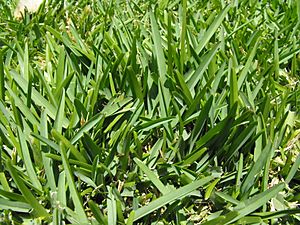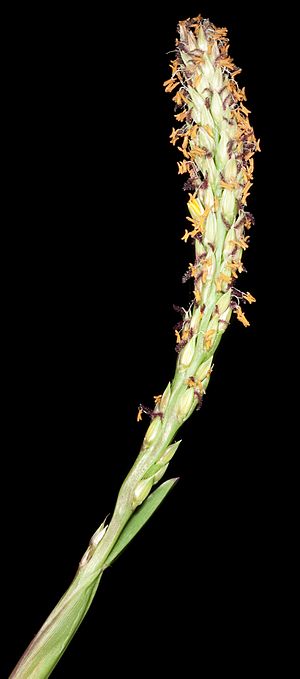St. Augustine grass facts for kids
Quick facts for kids St. Augustine grass |
|
|---|---|
 |
|
 |
|
| Scientific classification | |
| Genus: |
Stenotaphrum
|
| Species: |
secundatum
|
St. Augustine grass is a popular type of grass often used for lawns. You might also hear it called buffalo turf in Australia or buffalo grass in South Africa. This grass loves warm weather, so it grows well in tropical and subtropical parts of the world. It needs a bit of care, but it forms a thick, soft sod that looks like a carpet. This thick growth helps it keep most weeds and other grasses from growing.
Contents
What is St. Augustine Grass Like?
St. Augustine grass is usually a dark green color. Its blades are wide and flat. It spreads out using special stems that grow above the ground. These stems are often called "runners." They help the grass form a very thick layer.
You can find St. Augustine grass on both sides of the Atlantic Ocean. This includes places like the southeastern United States, Texas, Mexico, and Central and South America. It has also started growing on its own in California, Hawaii, many Pacific islands, South Africa, and New Zealand.
This grass grows well in most Caribbean and Mediterranean areas. It loves tropical climates the most. You often see it near lagoons and marshes, on shorelines, and in any place that has a lot of moisture.
How St. Augustine Grass Grows
For a long time, it was hard to find seeds for St. Augustine grass. Because of this, people usually grew it using small pieces of grass. These pieces are called plugs or sprigs. Sometimes, people would lay down large rolls of grass, called sod. Once the grass starts growing, it can spread and grow more all by itself.
St. Augustine grass can grow in many different kinds of soil. It prefers soil that is not too acidic or too basic. It usually blooms, or produces flowers, in the spring and summer months.
What is it Used For?
St. Augustine grass is often used in fields where animals graze, like pastures and ranches. It is also a very popular grass for lawns. Many people choose it over bermudagrass. However, St. Augustine grass does not handle drought (very dry weather) as well as bermudagrass.
Different Types of St. Augustine Grass
Scientists have developed several special types, or cultivars, of St. Augustine grass. Here are some of them:
- Captiva - This type came out in 2007. The University of Florida created it. It is good at fighting off a bug called the southern chinch bug. It also stays short, so it needs less mowing.
- Floratam - This type was released in 1973. It was created by the University of Florida and Texas A&M University. It can resist a plant disease called St. Augustine decline (SAD). However, it does not do well in cold weather or in shady spots.
- Floratine - This type came out in 1959. It has a darker color and a finer, softer texture. It can handle colder temperatures and does not need to be mowed as often.
- Palmetto - This type was released in the mid-1990s. It is a smaller grass with a lighter green color.
- Raleigh - This type came out in 1980. It can handle cold weather well. But it can easily get diseases or be bothered by insects.
- Sapphire - This type was released in 2004. It was chosen from Australia. It has dark blue-green leaves and purple runners. It also spreads out quickly.
- Seville - This type came out in 1980. It is similar to 'Floratam' but has a finer texture.
- Sir Walter - This type was released in 1996. It was made for Australian weather. It can handle heat and dry conditions well.
- Texas Common - This type is very similar to the wild St. Augustine grass. It is not used as much anymore because it can easily get the SAD virus, which has no cure.
- Variegatum - In 1993, this type won a special award called the Award of Garden Merit. It is a creeping grass that stays green all year. It has white stripes on its leaves.
See also
 In Spanish: Gramón para niños
In Spanish: Gramón para niños


